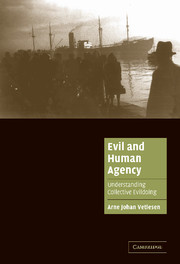Book contents
- Frontmatter
- Contents
- Preface
- A note on the cover image
- Introduction
- 1 The ordinariness of modern evildoers: a critique of Zygmunt Bauman's Modernity and the Holocaust
- 2 Hannah Arendt on conscience and the ‘banality’ of evil
- 3 The psycho-logic of wanting to hurt others: An assessment of C. Fred Alford's work on evil
- 4 The logic and practice of collective evil: ‘ethnic cleansing’ in Bosnia
- 5 Responses to collective evil
- 6 A political postscript: globalization and the discontents of the self
- References
- Index
- Evil and human agency
5 - Responses to collective evil
Published online by Cambridge University Press: 10 December 2009
- Frontmatter
- Contents
- Preface
- A note on the cover image
- Introduction
- 1 The ordinariness of modern evildoers: a critique of Zygmunt Bauman's Modernity and the Holocaust
- 2 Hannah Arendt on conscience and the ‘banality’ of evil
- 3 The psycho-logic of wanting to hurt others: An assessment of C. Fred Alford's work on evil
- 4 The logic and practice of collective evil: ‘ethnic cleansing’ in Bosnia
- 5 Responses to collective evil
- 6 A political postscript: globalization and the discontents of the self
- References
- Index
- Evil and human agency
Summary
Introduction
In the previous chapter, I elaborated a framework suited to exploring how collective evil may come about. While attention was mainly paid to the mentality and practice of perpetrators, we also looked closely at how such evil is experienced by the victims, especially in the case of rape.
In this final chapter, I shall employ as well as expand this framework. Collective evil of the kind I have been studying is a triadic phenomenon, not merely a dyadic one involving perpetrators and victims. It is triadic because the large-scale atrocities making up collective evil are tolerated or condemned, abetted or minimized by what is vaguely called third parties. To be sure, this is a vast and diffuse category, comprising individuals who, in their capacity as representatives of various bodies and institutions, may be: physically present on the scene (witnesses); assigned to monitor or inspect what unfolds (fact-finders); assigned to negotiate and possibly help influence the chains of events (diplomats); on peacekeeping or law-enforcing assignments; pursuing a political and/or moral interest (NGOs, intellectuals, engaged citizens); and, finally, the huge category of individuals who passively know that atrocities are taking place. My point is that the stance taken by each and every one of such third parties significantly impacts on the quality (intensity, extent, duration) of the collective evil in question.
- Type
- Chapter
- Information
- Evil and Human AgencyUnderstanding Collective Evildoing, pp. 220 - 288Publisher: Cambridge University PressPrint publication year: 2005

